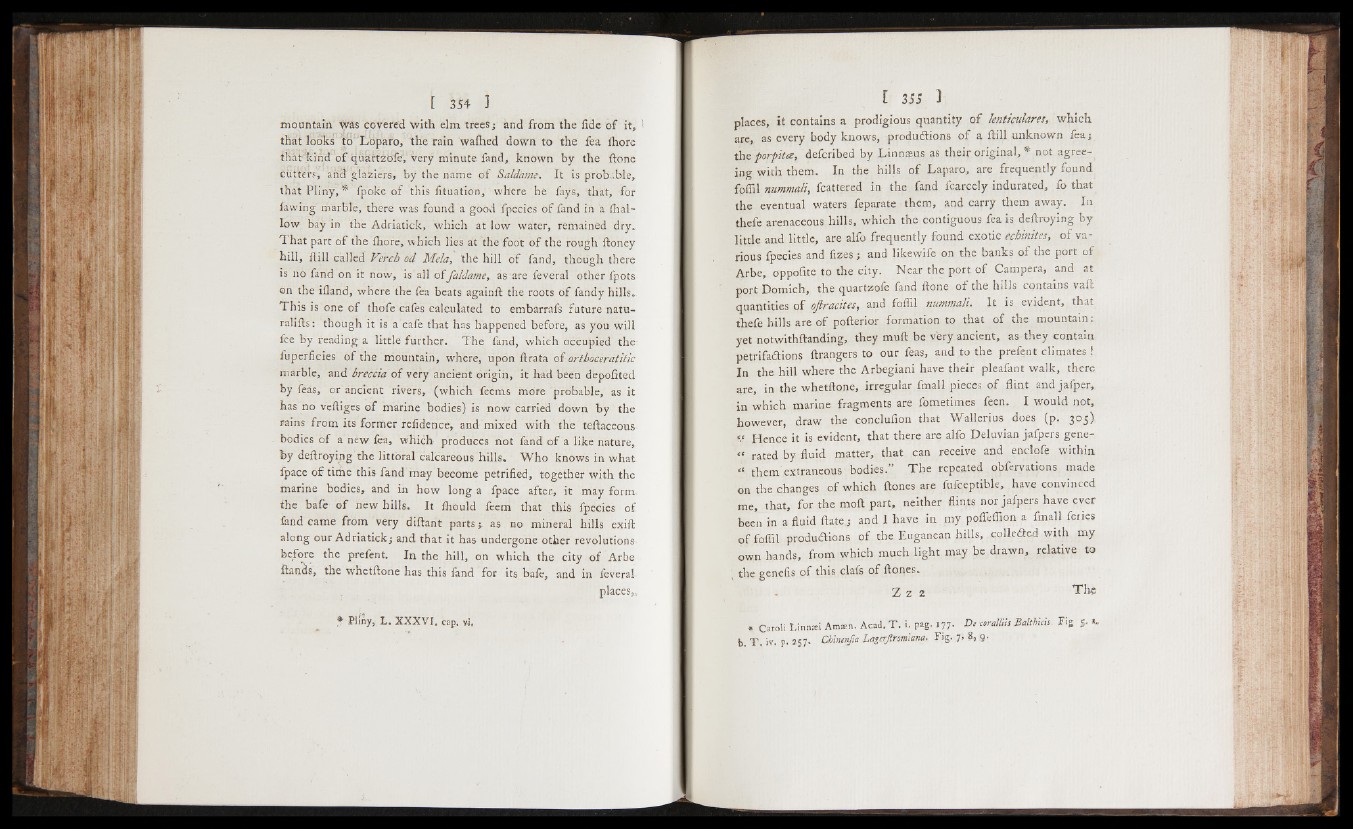
mountain was covered with elm trees; and from the fide o f it,
that looks to Loparo, the rain waihed down to the fea ihore
thatliind ’o f qu&rtzbfeV'very minute fand, known by the ftone
cutters, ana glaziers, by the name o f Saldame. It is probable,
that Pliny,* fpoke of this fituation, where he fays, that, for
fawing marble, there was found a good fpecies of fand in a {hallow
bay in the Adriatick, which at low water, remained dry.
That part o f the ihore, which lies at the foot o f the rough ftoney
hill, ftill called Verch od Mela, the hill o f fand, though there
is no fand on it now, is all offaldame, as are feveral other fpots
on the ifland, where the fea beats againft the roots o f fandy hills.
This is one o f thofe cafes calculated to embarrafs future natu-
ralifts: though it is a cafe that has happened before, as you will
fee by reading a little further. The fand, which occupied the
fuperficies o f the mountain, where, upon ftrata o f ortboceratitic
marble, and breccia of very ancient origin, it had been depofited
by feas, or ancient rivers, (which feems more probable, as it
has no veftiges o f marine bodies) is now carried down by the
rains from its former refidence, and mixed with the teftaceous
bodies of a new fea, which produces not fand o f a like nature,
by deftroying the littoral calcareous hills. ‘ Who knows in what,
fpace o f time this fand may become petrified, together with the
marine bodies, and in how long a fpace after., it may form
fhe bale o f new hills. It fhould feem that this fpecies of
land came from very diftant parts;. as no mineral hills exift
along our Adriatick; and that it has undergone other revolutions-
before the prefent. In the hill, on which the city o f Arbe
Hands, the whetftone has this fand for its bafe, and in feveral
places,.
* Pliny, L . X X X V I . cap. vi.
places, it contains a prodigious quantity o f lenticulares, which
are, as every body knows, productions o f a ftill unknown fea;
the porpitee, defcribed by Linnaeus as their original, * not agreeing
with them. In the hills of Laparo, are frequently found
fpifil nummali, fcattered in the fand fearcely indurated, fo that
the eventual waters feparate them, and carry them away. In
thefe arenaceous hills, which the contiguous fea is deftroying by
little and little, are alfo frequently found exotic echinites, o f various
fpecies and fizes; and likewife on the banks o f the poit o f
Arbe, oppofite to the city. Near the port of Campera, and at
port Domich, the quartzofe fand ftone o f the hills contains vaft
quantities of ojlracites, and foflil nummali, It is evident, that
thefe hills are o f poftenor formation to that of the mountain,
yet notwithftanding, they muft be very ancient, as-they contain
petrifactions ftrangers to our feas, and to the prefent climates !
In the hill where the Arbegiani have their pleafant walk, there
are, in the whetftone, irregular fmall pieces o f flint and jafper,
in which marine fragments are fometimes feen. I would not,
however, draw the conclufion that Wallerius does (p. 305)
3 Hence it is evident, that there are alfo Deluvian jafpers gene-
“ rated by fluid matter, that can receive and enclofe within
“ t h e m extraneous-bodies.” T he repeated obfervations made
on the changes o f which ftones are fufceptible, have convinced
me, that, for the moft part, neither flints nor jafpers have ever
been in a fluid ftatej and I have in my poifeflion a fmall feries
o f foflil productions o f the Euganean hills, collefled with my
own hands, from which much light may be drawn, relative to
the genefis of this clafs o f ftones.
Z z 2 T h e
. Carol; Linn*; A m o . Acad. T . i. pag. 177. D , toralliii Ealthlcis. Fig *.
b. T . iv. p. 257. Chinenfta Lagerftromiana. Fig. 7, 8, 9.